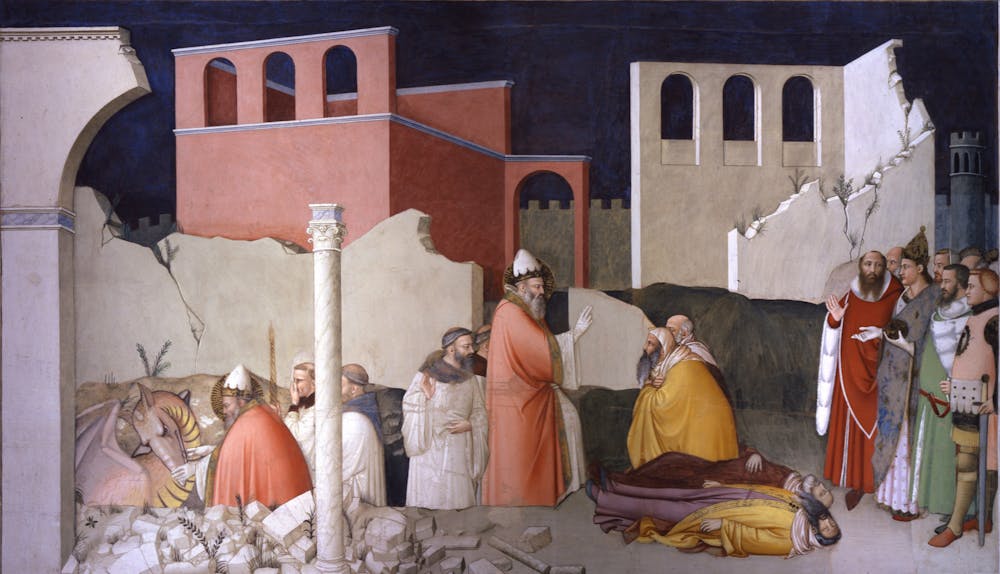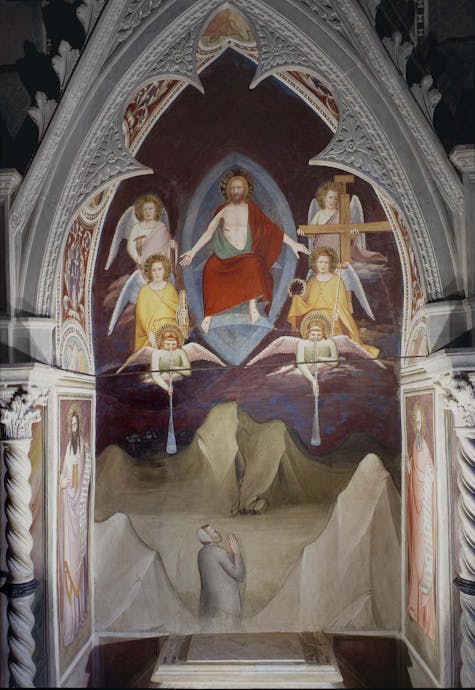
Bardi di Mangona Chapel
The Bardi di Mangona Chapel and the frescoes of Maso di Banco
Historians still question whether the fifth chapel in the north transept, dedicated to the Confessor Saints, was founded by Gualtieri de' Bardi or by his son Andrea. Andrea acquired the castle of Mangona in 1332, giving rise to a branch of the family that became known as the "Bardi di Mangona". The date of the decoration is also still controversial: some scholars argue that is was painted by 1335, others between 1336 and 1338, and others still between 1338 and 1341.
Contemporary scholarship is, however, unanimous in attributing to Maso di Banco the frescoes with the Stories from the Lives of St. Sylvester and Constantine illustrating the encounter between the Pope and the Emperor and the latter's eventual conversion. This was a fairly popular subject in the 13th and 14th centuries, against the backdrop of the struggle for power between the Papacy and the Holy Roman Empire. Works of literature and art were produced in support of papal policy, presenting Pope Sylvester in such a way as to counterbalance the glory of Constantine whose fame rested on his having granted freedom of worship to Christians in 313. Thus the stories of St. Sylvester are embellished with scenes in which the Pope becomes the true source of inspiration behind imperial policy in episodes that are either romanticised or devoid of all historical fundament, such as the Emperor's alleged baptism depicted in this chapel. The theme is further bolstered by the stained-glass windows, also attributed to Maso di Banco, with four pairs of figures comprising an emperor and the saint who guided him.

Maso di Banco, St. Sylvester Warns the Dragon and Revives Two Wizards Slain by the Monster's Pestilential Breath, scene from the Stories of the Lives of St. Sylvester and Constantine, 1332–5 or 1336–8. Basilica of Santa Croce, north transept, Bardi di Mangona Chapel
The frescoes and stained-glass illustrated the Bardi's close proximity with the Pope, their bank playing a leading role in the management of papal finances.
In the cultural context of the 14th century, the important social role played by the Bardi di Mangona was underscored by two tomb monuments on the left-hand wall, of a type reserved for only a very few members of the élite.
The first tomb, possibly designed for the men of the family, is adorned with a rare scene depicting Individual Judgment frescoed by Maso di Banco, while the sculptural part of the tomb has been attributed both to Giovanni di Balduccio and to Agnolo di Ventura. Less problematic is the second tomb, reserved for the women of the family, with a Deposition painted by Taddeo Gaddi after 1341.

Maso di Banco, Individual Judgment, detail of the Tomb monument of the Bardi di Mangona, 1332–5 or 1336–8. Basilica of Santa Croce, north transept, Bardi di Mangona Chapel
Patronage of the chapel was transferred to the Bardi di Vernio in 1602 and it was known by that name for a considerable length of time, in old sources and even in contemporary texts.
Unlike the other cycles in Santa Croce, these frescoes were not whitewashed over in the 18th century, yet they have been damaged by rainwater repeatedly leaking through the back wall in particular, and by a fair amount of repainting. Recent restoration, in 1998, has consolidated the fresco cycle and revealed Maso di Banco's original work.